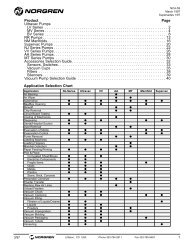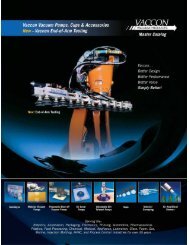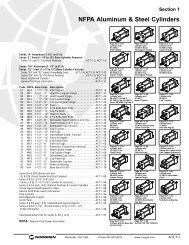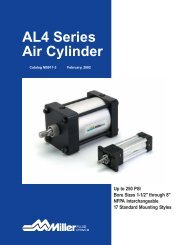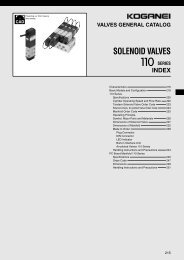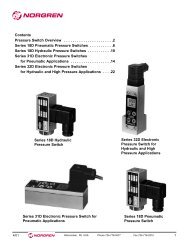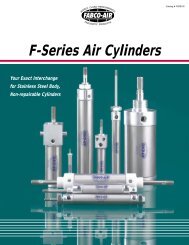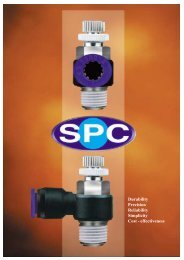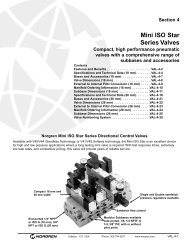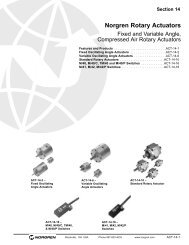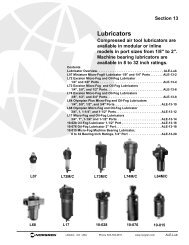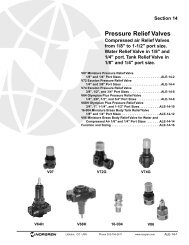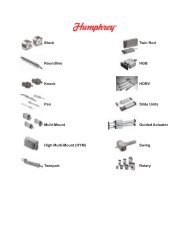Catalog M1136Handling PrecautionsCompact Hydraulic Cylinders<strong>Series</strong> <strong>CHL</strong> & <strong>CHH</strong>Installation and Maintenance• Fully torque machine components to the piston rodshoulder so that no force is applied to the piston rodthread on push applications.• During installation, make adjustments carefullybecause a lateral or eccentric load cannot be applied tothe piston rod.• When operating the cylinder for the first time, be sure tobleed the air from the piping. After bleeding the air,operate the cylinder at low pressure, and graduallyincrease the pressure to reach operating pressure.NOTE: The <strong>CHL</strong> and <strong>CHH</strong> series cylinders are not providedwith air vents. Therefore, bleed the air via the piping.• To install the cylinder, 4 socket head screws (JIS B1176,strength classification of 10.9 or more) shall be used.• When using the mounting bolts, screw 80% or more ofthe threaded portion of bolts into the material to bemounted. The material to be mounted must have thestrength that is equivalent to the SS400 material quality.• To tighten the mounting bolts with nuts, use steel nutswith the strength classification of 6 or more. (However,do not use type 3.)• When threading mounting bolts through the cylinders,be sure to tighten them using the torque valuesindicated in the table below.Cylinder Mounting Bolt Tightening Torque TableTighteningMounting Bolt Size TorqueBore Inch Metric N-m (ft-lbs)20 10 – 24 M5 X 0.8 4.8 (3.54)25 10 – 24 M5 X 0.8 4.8 (3.54)T32 1/4 – 20 M6 X 1 8.1 (5.97)Mount 40 5/16 – 18 M8 X 1.25 20 (14.75)50 3/8 – 16 M10 X 1.5 40 (29.50)63 1/2 – 13 M12 X 1.75 67 (49.42)80 1/2 – 13* M14 X 2 110 (81.14)100 5/8 – 11 M16 X 2 120 (88.51)32 5/16 – 18 M8 X 1.25 20 (14.75)C 40 3/8 – 16 M10 X 1.5 40 (29.50)Mount 50 1/2 – 13 M12 X 1.75 67 (49.42)63 1/2 – 13* M14 X 2 110 (81.14)*When using socket head screws, flat washers are required.Flat washer dimensions: OD must be 0.846" (21.5mm)~0.886" (22.5mm).O.D.Flat WasherSocket Head Screw• The compact design of the piping port allows for fittings(B) with threads in the sizes listed below. An improper fitmay damage the cylinder, resulting in poor performance.Unit: mm (inch)CylinderBoreSize Port Size B20 NPT 1/8 6.3 (0.25)25 NPT 1/8 6.3 (0.25)32 NPT 1/4 9.5 (0.374)40 NPT 1/4 9.5 (0.374)50 NPT 1/4 9.5 (0.374)63 NPT 1/4 9.5 (0.374)80 NPT 3/8 10.5 (0.413)Disassembly and Reassembly PrecautionsCylinders, as shipped from the factory, are not to be disassembledand/or modified. If cylinders require modifications,these modifications must be done at Miller <strong>Fluid</strong> Powerlocations or by Miller <strong>Fluid</strong> Power-certified facilities. It isallowed to disassemble cylinders for the purpose of replacingseals or seal assemblies. However, this work must be done bystrictly following all the instructions provided with the seal kits.Set Screw(Hexagon Wrench)Turning HolePiping Port• After removing the set screw, utilize the turning hole of therod gland to remove the rod gland from the cylinder body.When removing a jig from the rod end threads, burrs maybe created on the width across flats of the rod. In thatcase, use a file to remove the burrs; then, remove the rodgland.• The piston rod and piston cannot be disassembled.• If the cylinder has been disassembled, make sure toreplace all sealing materials (seals and gaskets).• During the reassembly of the cylinder, make sure that nodust or debris such as metal particles enter the cylinder.• A brass plug for protecting the threads of the rod gland islocated below the set screw. This plug must be removedbefore tightening the rod gland.• After tightening the rod gland, install the brass plug that isincluded in the seal set and tighten the set screw.• The general-purpose piston seal, rod seal, dust wiper,and rod gland o-ring can be replaced.B• To tighten the piston rod end threads of the double acting,double rod type, make sure to use the width across flats ofthe rod to be tightened. Because the double rod is joinedby threads, caution shall be taken so that rotational force isnot applied to the rod.16Miller <strong>Fluid</strong> PowerDes Plaines, ILToronto, Ontario Canada
Catalog M1136Permissible Energy of InertiaCompact Hydraulic Cylinders<strong>Series</strong> <strong>CHL</strong> & <strong>CHH</strong>Permissible piston impact speed is limited due to the size of the load attached to the rod end. That speed should be below thebold lines on the chart.<strong>CHL</strong>10050ø 40 ø 32Speed(mm/s)ø 50ø 25 ø 20ø 80 ø 100ø 63108 1 51050100 500 1000Load (kg)<strong>CHH</strong>10050ø 80Speed(mm/s)10ø 20ø 63ø 40ø 25ø 50ø 328 1 510Load (kg)50100 500 1000Theoretical Push and Pull ForcesGeneral FormulaThe cylinder output forces are derived from the formula:F =P x A10000Where F = Force in kN.P = Pressure at the cylinder in bar.A = Effective area of cylinder piston insquare mm.If the piston rod is in compression, use the ‘Push Force’ tablebelow, as follows:1. Identify the operating pressure closest to that required.2. In the same column, identify the force required to movethe load (always rounding up).3. In the same row, look along to the cylinder bore required.Push ForceBore BoreCylinder Push Force in kNø Area 10 40 63 100 125 160mm sq. mm bar bar bar bar bar bar20 314 0.3 1.3 2.0 3.1 3.9 5.025 491 0.5 2.0 3.1 4.9 6.1 7.932 804 0.8 3.2 5.1 8.0 10.1 12.940 1257 1.3 5.0 7.9 12.6 15.7 20.150 1964 2.0 7.9 12.4 19.6 24.6 31.463 3118 3.1 12.5 19.6 31.2 39.0 49.980 5027 5.0 20.1 31.7 50.3 62.8 80.4100 7854 7.9 31.4 49.5 78.5 98.2 125.7If the cylinder envelope dimensions are too large for theapplication, increase the operating pressure, if possible,and repeat the exercise.If the piston rod is in tension, use the ‘Deduction for PullForce’ table. The procedure is the same but, due to thereduced area caused by the piston rod, the force availableon the ‘pull’ stroke will be smaller. To determine the pull force:1. Follow the procedure for ‘push’ applications asdescribed above.2. Using the ‘pull’ table, identify the force indicatedaccording to the rod and pressure selected.3. Deduct this from the original ‘push’ force. The resultant isthe net force available to move the load.If this force is not large enough, repeat the process andincrease the system operating pressure or cylinder diameterif possible. For assistance, contact your local authorizeddistributor.Deduction for Pull ForcePistonRodømmPistonRodAreasq. mmReduction in Force in kN10 40 63 100 125 160bar bar bar bar bar bar12 113 0.1 0.5 0.7 1.1 1.4 1.814 154 0.2 0.6 1.0 1.5 1.9 2.518 255 0.3 1.0 1.6 2.6 3.2 4.122 380 0.4 1.5 2.4 3.8 4.8 6.128 616 0.6 2.5 3.9 6.2 7.7 9.936 1018 1.0 4.1 6.4 10.2 12.7 16.345 1591 1.6 6.4 10.0 15.9 19.9 25.556 2463 2.5 9.9 15.5 24.6 30.8 39.417Miller <strong>Fluid</strong> PowerDes Plaines, ILToronto, Ontario Canada



